The header image on this page shows the “Camas Prairie” in Idaho. For more on camas, see the post entitled “Camas.”
Originally we were going to have this website be devoted to native plants. But some of us are farther along in “going native” than others. So we decided to include on the website any topic concerning what’s happening in our yards. This will include animals as well as plants and you may see an occasional post about our pets!
BTW, we debated having the title be “FROM BEES TO WEEDS” or “FROM WEEDS TO BEES.” The truth is you can’t have one without the other. Nature is all intertwined and we ignore this at our peril! Hopefully we are all changing our concept of what’s a “weed!” One thing we are learning for sure — without the “weeds” we won’t have the bees or other pollinators. This has been made all too obvious from the plight of the Monarch butterfly.
This embroidery hung in our parents’ kitchen for many years. Who knows how it may have influenced our interests and concerns to this day?
Below are “bios” for each of us telling what our special interests are.
Debra (Delaware):
I live in Delaware on the piedmont/coastal plain, with hot, humid summers and moderate (usually!) winters. My interest in native flowers began several years ago as I struggled with getting annuals to survive the unfortunate location of my house with an oven-like front garden on the south, and a shade garden on the north. I had fallen in love with wildflowers while hiking over the years (my other pastime), and thought that maybe I could try planting some shade-loving natives on my north side. So I started replacing hostas and vincas with ferns, foam flowers, and other woodland flowers. Success! I then moved on to the east side of my house and then a small butterfly/hummingbird garden. By then I was smitten! I have to say that I’m really not much of a gardener–I always apologize to my plants as I’m putting them in the ground because they are pretty much on their own from then on!
Other interests include my backyard bluebird box and hummingbirds, the bluebird box trail that I monitor for the nearby state park, and volunteering at a bird rescue and rehab facility and for the Delaware Nature Society.
I also, BTW, am totally smitten by my cat (kitten), Silas. You’re liable to hear a lot about him.
Wendy (Georgia):
I am Wendy, Ruth sister #4. I live in Georgia, just south of Atlanta.
More than thirty years ago, I embroidered and framed a gardening sentiment that rang true for me then and still rings true for me today. The plaque reads, “The thing I grow most in my garden is tired.” Truth is, I tend to choose hobbies that do not include sweat, snakes, or ticks. The Georgia red clay may be good for growing cotton, but as far as I know, not much else.
By now, it must be evident I am the novice in native plant gardening. I am in awe of my sisters’ knowledge and love of native plants and so I am along for the ride. Actually, the low maintenance advantage of native plants caught my attention. I also appreciate their attractiveness to bees and butterflies. And so, with the planting of milkweed, I venture into the world of native gardening.
Leslie (Idaho):
This is Leslie, Ruth Sister No. 3. I live a few miles outside of Mountain Home, a small town in Idaho. The town’s name is a misnomer. We can see mountains, but we live in the desert.
Eighteen years ago when my husband and I decided to make our home on five acres of sagebrush and tumbleweeds, we weren’t focused on native plants. Our goal was to use the land to provide food and cover for birds, while respecting issues such as fire safety and water conservation. Our main plantings were Russian olives, autumn olives, junipers, and a wild rose hedge. As they thrived, we added a few other shrubs and trees which do well in Idaho such as willows and aspens. New plants keep showing up unexpectedly. For example, a week ago we discovered a 14 ft. tall apple tree loaded with apples, pushing out from a tangle of autumn olives. We are guessing it is a gift from one of the many birds who pass through on their way to here and there. We also put in a small pond. Quail, pheasants, and smaller birds visit regularly, and a family of toads have residence there. The pond is surrounded by volunteer flowers and clover that show up every year and attract bees and butterflies.
Like Robin, I love flowers, but I haven’t had a lot of success with them. Most of my gardening has been of the vegetable variety, a pastime which brings me much pleasure. (Maybe I just like to eat.) This spring, thanks to a generous birthday gift from my siblings, I planted a variety of native flowering plants and shrubs. Most are still alive, but the jury is out on the question of their ultimate survival. I visit them daily to make sure they are still there.
Bonnie (Colorado):
I am Bonnie, Ruth sister #2. I have lived in Colorado for 46 years and in my present home in south central Denver for 29 years. Every spring for most of that time, I would become ambitious about gardening and plant lots of flowers. I had no idea what I was doing, and most of my projects came to naught. I also attempted some vegetable gardening, with similar success or lack thereof. . Tomatoes always did well in my Earth Box, and pumpkins and squash did beautifully for a couple of years, until the squirrels discovered them. The squirrels must communicate foraging information down the generations, because I have not been able to get a squash to maturity since. My best successes over the years have been with herbs grown in pots on the patio (parsley, basil, thyme, etc.). Our Colorado clay soils and desert climate have not helped; carrots look like undersized radishes, and radishes look like nothing at all.
A few years ago my husband and I bought a house right next door. We sort of did it with a gun at our heads because a developer who would have scraped it and built a monster in its place was right behind us. Our thinking at first was that we would fix it up and make it a rental, but then we got the idea of moving our home offices into it and getting the use of the second yard. So we took down the fence between the properties, and suddenly the gardening possibilities were endless. Then I read the book that changed my gardening life, Bringing Nature Home by Doug Tallamy, about the importance of native gardening to save the insects (including especially the Monarch butterfly) and the birds that depend on them. That year I stopped attempting carrots and radishes and planted milkweed. Now my son and daughter in Denver are also growing milkweed.
We also added native fruit trees to both yards, along with bee balm, Joe Pye weed, and other natives or at least nectar plants.
So what really drives my gardening turns out to be not primarily the plants themselves, although I enjoy them, but the animals that we Ruth sisters all love.
My pets right now are 2 Maine coon cats and an Alaskan husky mix that I am bananas about. I have posted pictures of the cats, but the dog is terrified of cameras (among many other things), so pictures of her are harder to come by.
Robin (Virginia):
A year ago I decided to abandon all vegetable gardening and instead try to grow what really interested me — native plants for butterflies and bees and other pollinators (including goldfinches and hummingbirds). I especially love those flowers that come up all by themselves. That’s why in my pictures you’ll see a lot of Daisy Fleabane and Black-eyed Susan. I have a very long backyard and really did not anticipate all the weeding that would be required by turning about half of it into a “garden.”
Also I have 3 cats and a dog I’m nuts about. You’re likely to see a few pictures of them. And bluebirds — I have them nesting in my backyard and I’ve tried to get a few pictures of them as well.

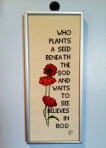
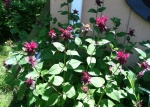
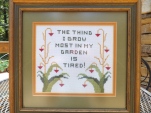
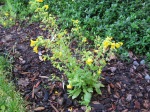
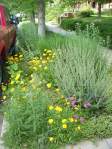
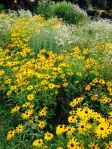
All right, Robin! We’re off to a great start! Deb